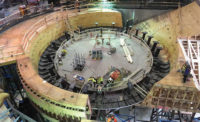Back-to-Back Canada Construction Job Losses Puzzle Industry
Canada’s otherwise booming construction sector has shed jobs for two months in a row, taking observers and industry executives by surprise.
Construction employment fell by 1.1% in August, with a drop of more than 16,000 jobs, according to Statistics Canada, the government-run data agency.
That followed a .8% decline in July when the total number of workers in construction in Canada fell by over 12,000, reports StatCan, which notes the numbers are seasonally adjusted.
While not enough to declare a trend, the declines are part of a larger pattern that has seen the number of workers employed in construction level off in 2018 after strong growth in 2017.
Construction employment in Canada peaked last December at 1.447 million after expanding by a robust 3.6% over the course of 2017.
Growth has since leveled off, with total employment in the building sector at 1.418 million in August.
“If you look at the number of people employed in construction, there were several months of increases during the second half of 2017, increasing to a peak in December, 2017,” notes Marton Lovei, a StatCan analyst.
The more sluggish pace of growth appears to coincide with a slower than expected launch of major infrastructure projects under Prime Minister Justin Trudeau’s much-touted plan to spend more than $138 billion over the next 12 years on everything from light rail to new housing.
In April, the Liberal government announced that $2.7 billion in infrastructure spending that had been set for early 2018 would instead by delayed until later years, generated by both federal decisions and slow-moving agreements with provincial and local governments, who also put in substantial amounts of money.
A mandate letter by Trudeau to newly installed Infrastructure Minister François-Philippe Champagne has been widely read as expressing frustration over the slower than expected rollout of infrastructure money. Trudeau urges the new minister to finalize infrastructure agreements with provincial leaders, a job left undone by Champagne’s predecessor, Amarjit Sohi, who recently was named to a different government post.
Ian Cunningham, president of the Council of Ontario Construction Associations, acknowledged that slower than expected infrastructure spending could be a factor in the surprising numbers.
“Of course, governments across the country have been slower than they might have been in advancing monies for new projects,” he said.
But in general, Cunningham and other industry leaders say they remain “perplexed,” contending that they see a tight labor market in which contractors are struggling to find enough workers.
“All the people I talk to are as busy as they have ever been and some are having trouble finding labor,” he said.




